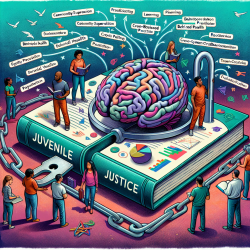Introduction
The juvenile justice system (JJS) is a complex network that requires effective collaboration between community supervision (CS) agencies and behavioral health (BH) providers to address the multifaceted needs of youth. A recent study titled Juvenile justice systems of care: results of a national survey of community supervision agencies and behavioral health providers on services provision and cross-system interactions offers insights into these interactions, highlighting areas for improvement and potential for further research.
Understanding the Research
The study aimed to evaluate the extent to which elements in the cascade model of behavioral health services are provided to youth by CS and BH providers. It used a multistage probabilistic survey design to sample CS agencies and their primary BH service providers in the United States. The study focused on the characteristics of youth served, the availability of BH services, the use of evidence-based practices (EBPs), and the methods of collaboration and referral between CS and BH providers.
Key Findings
- Youth referred from CS to BH programs represent a more severe subgroup of youth under CS supervision.
- There are established cross-system relationships for assessment and referral for substance use and mental health treatment, but less so for prevention services.
- Most CS programs refer youth to BH providers for these services, which typically utilize more highly trained staff to provide EBPs to a majority of the youth served.
- More intensive substance use and mental health treatment, aftercare, and recovery support services were limited in availability.
Implications for Practitioners
For practitioners working within the juvenile justice system, the study highlights several areas for potential improvement:
- Enhance Cross-System Collaboration: Establish more robust referral systems and information exchange protocols to ensure seamless service delivery across CS and BH providers.
- Expand Availability of Intensive Services: Increase access to intensive substance use and mental health treatments, as well as aftercare and recovery support services, to address the needs of youth with higher levels of severity.
- Implement Evidence-Based Practices: Ensure that services provided are grounded in EBPs to improve outcomes for youth.
- Focus on Prevention: Develop and integrate prevention services within the system to address issues before they escalate.
Encouragement for Further Research
While the study provides valuable insights, it also underscores the need for further research to explore the relationship between systems-of-care characteristics and youth outcomes, such as recidivism. Practitioners are encouraged to delve deeper into the data and collaborate with researchers to develop interventions that address identified gaps within JJ systems of care.
Conclusion
By leveraging the findings of this study, practitioners can enhance their skills and improve service delivery within the juvenile justice system. The focus should be on strengthening cross-system collaboration, expanding intensive services, implementing EBPs, and prioritizing prevention. These efforts will ultimately lead to better outcomes for youth involved in the juvenile justice system.
To read the original research paper, please follow this link: Juvenile justice systems of care: results of a national survey of community supervision agencies and behavioral health providers on services provision and cross-system interactions.










